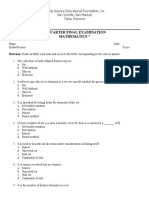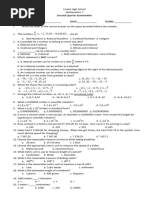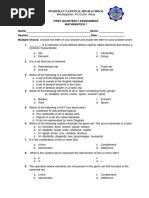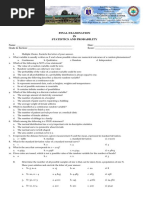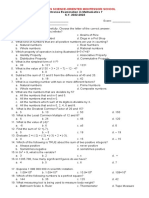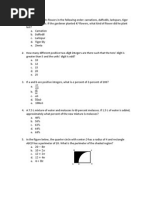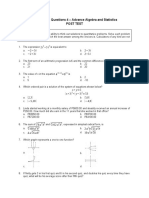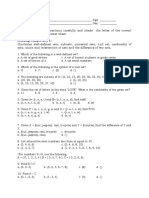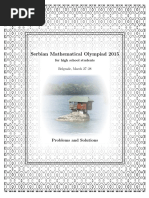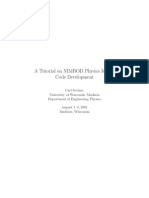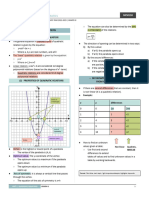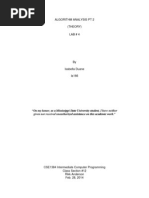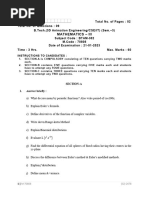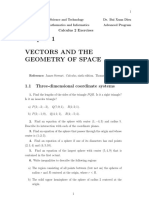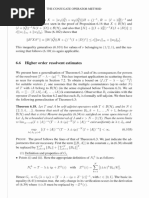Jayvie TQS
Jayvie TQS
Uploaded by
Christian AglidayCopyright:
Available Formats
Jayvie TQS
Jayvie TQS
Uploaded by
Christian AglidayOriginal Description:
Original Title
Copyright
Available Formats
Share this document
Did you find this document useful?
Is this content inappropriate?
Copyright:
Available Formats
Jayvie TQS
Jayvie TQS
Uploaded by
Christian AglidayCopyright:
Available Formats
Our Lady of the Pillar College-San Manuel, Inc.
District 3, San Manuel, Isabela, Philippines
College Department S.Y. 2022– 2023
Name: _____________________________________________Yr. & Sec.: _______________
I. MULTIPLE CHOICES: Read and understand each statement carefully then encircle the correct
answer from the given choices.
1. Which of the following is the set of glow foods?
a. A = {bread, potato, rice}
b. B = {fish, chicken pork}
c. C = {lettuce, eggs, oats}
d. D = {lettuce, corn, cabbage}
2. What is the cardinality of the set “mathematically”?
a. 14
b. 9
c. 10
d. 15
3. Which of the following is the set of grow foods?
a. A = {bread, potato, rice}
b. B = {lettuce, eggs, oats}
c. C = {fish, chicken pork}
d. D = {milk, butter, cheese}
4. Which of the following is the symbol of a null set?
a. ∩
b. ᴗ
c. ≥
d. ø
5. Which of the following is a subset of L = {6, 7, 8}?
a. {0}
b. {0, 6}
c. {6, 7}
d. {6, 7, 8}
6. What do we call a well-defined set of items with same properties?
a. Set
b. Elements
c. Subset
d. Union
7. What is the name of the set formed by combining the components of two sets?
a. Set
b. Elements
c. Subset
d. Union
8. What is the cardinality of the set “supercalifragilisticexpialidocious”?
a. 34
b. 14
c. 12
d. 18
For # 9 to 11, refer to the statement below.
In a group of 200 students, 172 can speak Japanese and 143 can speak Korean.
9. How many students can speak Japanese only?
a. 172
b. 200
c. 57
d. 143
10. How many students can speak Korean?
a. 172
b. 200
c. 143
d. 28
11. How many can speak both Japanese and Korean?
a. 143
b. 115
c. 200
d. 172
For item number 12-16, refer to the statement below.
90 people went on a field trip, 3 had fries, shake, and orange; 5 had fries and shake; 10 had orange and shake;
8 had orange and fries; 24 had fries; 38 had shake; 20 had an orange.
12. How many people had nothing?
a. 0
b. 8
c. 90
d. 3
13. How many people had shake only?
a. 90
b. 10
c. 59
d. 38
14. How many people had orange only?
a. 90
b. 10
c. 38
d. 20
15. How many people had fries only?
a. 90
b. 24
c. 40
d. 59
16. How many people had fries and shake?
a. 90
b. 24
c. 5
d. 8
17. Which of the following denotes the distance between two numbers on a number line?
a. Absolute Value
b. Integers
c. Rational Number
d. Scientific Notation
18. What is the sum of -42 and -22?
a. 64
b. -64
c. -20
d. 20
19. What is the difference between -78 and -30?
a. -108
b. 108
c. -48
d. 48
20. Find the product of -45 and -5?
a. -225
b. 225
c. -40
d. 40
21. What is the quotient of 80 and 8?
a. 88
b. 10
c. -10
d. 88
22. Find the product of -24 and 5?
a. 29
b. 120
c. -29
d. -120
23. What is the sum of -86 and 56?
a. 142
b. -30
c. -142
d. 30
24. Which of the following is a number that can be expressed as the quotient or fraction of two integers?
a. Absolute Value
b. Integers
c. Rational Number
d. Scientific Notation
25. In the expression 20 (4-5) = 20(4) – 20(5), which of the following properties is used?
a. Additive inverse
b. Additive identity
c. Associative property
d. Distributive property
26. In the expression (2+8) + 4 = 2 + (8+4) = 14, which of the following properties is used?
a. Additive inverse
b. Additive identity
c. Associative property
d. Distributive property
27. Which of the following demonstrate the Commutative Property?
a. a + 12 = 12 + a
b. pq = qp
c. o + p = p +
d. 3x(4) = 12x
28. Which of the following demonstrate the Distributive Property?
a. 16 (4-8) = 16(4) - 16(8)
b. (10 – 6) + 4 = 10 + (-6 + 4)
c. 2x (10 - 3) = 2x(10) – 2x(3)
d. a ( b - c) = a(b) – a(c)
29. What integer property justifies this 15 + 5 = 5 + 15?
a. Closure Property
b. Identity Property
c. Inverse Property
d. Commutative Property
30. What integer property justifies this (-5 + 10 + 7 = -5 + (10 + 7)?
a. Additive inverse
b. Additive identity
c. Associative property
d. Distributive property
31. Which of the following statements is true: the sum of any integer and 0 equals the specified number?
a. Closure
b. Commutative
c. Associative
d. Identity
32. What do we call the associative property asserts that changing the numbers that are being added or
multiplied has no effect on their value?
a. Product
b. Order
c. Grouping
d. Factor
33. What do we call to a number with decimal point separating the whole number and the number component?
a. Set
b. Fraction
c. Percent
d. Decimal
34. What is the value of 0.25 expressed as a fraction?
a. ½
b. 1/3
c. ¼
d. 2/3
35. On the quiz, Jefron answered 6/8 of the questions correctly. What is the decimal equivalent of that fraction?
a. 0.725
b. 0.625
c. 0.650
d. 0.750
36. In decimal form, what is the value of ¼?
a. 0.75
b. 0.25
c. 0.125
d. 0.50
37. Which of the following specifies the number of sections of a given size?
a. Decimal
b. Fraction
c. Set
d. Percent
38. On the test, Angel answered 34 of the questions correctly. What is the decimal equivalent of that fraction?
a. 0.50
b. 0.12
c. 0.75
d. 1.2
39. What is the figure or ratio stated as a percentage of 100?
a. Set
b. Fraction
c. Percent
d. Decimal
40. What is the value of 0.25 expressed as a fraction?
a. ½
b. 1/3
c. ¼
d. 2/3
II. TRUE OR FALSE: Read and understand each statement carefully then write T if the statement is true
and write F if the statement is false. Write your answer on the space provided.
41. It is necessary for rational numbers to be represented by a fraction. True
42. Repeating decimals like .666666..... cannot be a rational number. False
43. π is not a rational number True
44.1/2 is a rational number True
45.√36 is a rational number True
46.√13 is a rational number. False
47. All square roots are irrational. False
48. 87/87 is a rational number. True
49. A repeating decimal represents rational numbers. True
50. We cannot express any irrational number in the form of a ratio, such as p/q, where p and q True
are integers, q≠0.
III. IDENTIFICATION: Read and understand each statement carefully then write your answer on the space
provided.
51.
52.
53.
54.
55.
56.
57.
58.
59.
60.
IV. MATCHING TYPE: Read and understand each statement carefully then write your answer on the space
provided.
61. Symbolizes a number's positive square root. a. Square root range ______
62. Shows whether the irrationality of the principal b. Plotting irrational number ______
root
63. Finds the range of two integers that the square c. Principal roots application ______
root of a given number falls between.
64. Finding the square's diagonal. d. Applying number line plotting ______
65. Finding a variable's potential values within an e. Principal roots ______
equation system.
66. Describing the procedure for figuring out if a f. Square root estimation ______
principal root is irrational.
67. Taking the whole number’s square root and g. Applying square root estimation ______
rounding it to the nearest hundredth.
68. Using a number line diagram to represent h. Determining irrationality ______
irrational numbers.
69. Finding a whole number’s square root in a i. Plotting irrational numbers ______
practical situation and rounding to the nearest
hundredth.
70. Displaying irrational numbers on a number line j. Understanding principal roots, ______
diagram, as √2 or √5. irrationality, and range
k. Determining irrationality and
range.
GOODLUCK!!!
Prepared by: Checked and Approved:
Jayvie S. Corpuz Marijoe M. Pimentel
BSEd – Math 3 Instructor
You might also like
- Second Quarterly Test in Math 3 - TagalogDocument4 pagesSecond Quarterly Test in Math 3 - TagalogOLIVIA LUMBRE100% (8)
- Mathematics 7Document2 pagesMathematics 7manilynNo ratings yet
- 1 Quarter Final Examination Mathematics 7Document6 pages1 Quarter Final Examination Mathematics 7Maria Martina Delos SantosNo ratings yet
- 2nd Math7Document2 pages2nd Math7Mic MicNo ratings yet
- Assessment 7 PeacDocument5 pagesAssessment 7 PeacEliza Antolin CortadoNo ratings yet
- Local Media2940086235549393260Document5 pagesLocal Media2940086235549393260bellegutingNo ratings yet
- Diagnostic Test MATH 4Document3 pagesDiagnostic Test MATH 4Neriza JeanNo ratings yet
- Davao Oriental State College of Science and Technology: Republic of The PhilippinesDocument8 pagesDavao Oriental State College of Science and Technology: Republic of The PhilippinesRanny DueñasNo ratings yet
- First Periodic Examination Math 7Document5 pagesFirst Periodic Examination Math 7Jonel TuazonNo ratings yet
- Supplementary Exam in Mathematics 8Document7 pagesSupplementary Exam in Mathematics 8Christian Nathaniel Ramon PalmaNo ratings yet
- Math 7 DATDocument4 pagesMath 7 DATAsma AmpangNo ratings yet
- 2nd Quarter Exam MATH 7Document3 pages2nd Quarter Exam MATH 7NIDA DACUTANAN67% (3)
- Computer Entrance PreviousDocument7 pagesComputer Entrance Previousarjunkj500No ratings yet
- Math ReviewerDocument13 pagesMath ReviewerLinzy MamornoNo ratings yet
- PT Mathematics 5 q3Document6 pagesPT Mathematics 5 q3Chistine Rose EspirituNo ratings yet
- LET TQ MathDocument13 pagesLET TQ MathAngel Constantine BajanaNo ratings yet
- It Represents The Distance of A Number On A Number LineDocument4 pagesIt Represents The Distance of A Number On A Number LineEuchel Pauline RamosNo ratings yet
- Math 7 - Summative Week 678Document2 pagesMath 7 - Summative Week 678Brian MaryNo ratings yet
- g7 First Periodical ExamDocument2 pagesg7 First Periodical Examjose dave salsalidaNo ratings yet
- Grade 7 First Quarter ExamDocument5 pagesGrade 7 First Quarter ExammaanramonNo ratings yet
- First Periodical Exam For Grade 7Document5 pagesFirst Periodical Exam For Grade 7Emelyn V. Cudapas100% (1)
- Math 7 Second QTR Summative Test 2021 2022Document5 pagesMath 7 Second QTR Summative Test 2021 2022Tsej IsaacNo ratings yet
- Periodic Test in Math 7Document3 pagesPeriodic Test in Math 7Mon DilligNo ratings yet
- Competency Appraisal MArch 232024Document130 pagesCompetency Appraisal MArch 232024Adrian VillaneaNo ratings yet
- Quarter 2 Post-TestDocument4 pagesQuarter 2 Post-TestRoberto Del CarmenNo ratings yet
- Pretest Gecmat 1st Sem 2020 For StudentsDocument6 pagesPretest Gecmat 1st Sem 2020 For StudentsMary Chris Tad-yNo ratings yet
- Mnhs Mathematics 7 Quarter 2 ExamDocument3 pagesMnhs Mathematics 7 Quarter 2 ExamNORVEEN CAMPANILLANo ratings yet
- Paharang Integrated School: Department of EducationDocument10 pagesPaharang Integrated School: Department of EducationMarina AcuñaNo ratings yet
- Mnhs Math 7 Quarter 2 ExamDocument3 pagesMnhs Math 7 Quarter 2 ExamNORVEEN CAMPANILLANo ratings yet
- Mnhs Mathematics 7 Quarter 1 ExamDocument3 pagesMnhs Mathematics 7 Quarter 1 ExamNORVEEN CAMPANILLANo ratings yet
- Grade 7Document3 pagesGrade 7Nodelyn ReyesNo ratings yet
- First Periodical Test in Math 7Document2 pagesFirst Periodical Test in Math 7MyraFlorMotinFegalan100% (4)
- Math 7 1st Grading ExamDocument3 pagesMath 7 1st Grading ExamRickrick EspinaNo ratings yet
- Final Examination IN Statistics and ProbabilityDocument3 pagesFinal Examination IN Statistics and ProbabilityPing Homigop JamioNo ratings yet
- Numbersystem-Worksheet 240428 083452Document5 pagesNumbersystem-Worksheet 240428 083452ALWIN BOBYNo ratings yet
- Civil Service Exam Reviewer for Professional and Sub Professional Levels v2 2.pDocument160 pagesCivil Service Exam Reviewer for Professional and Sub Professional Levels v2 2.pNerissa ObliagaNo ratings yet
- Diagnostic Test Math 7Document3 pagesDiagnostic Test Math 7Danica CapinaNo ratings yet
- Mnhs Mathematics 7 Quarter 1 ExamDocument4 pagesMnhs Mathematics 7 Quarter 1 ExamNORVEEN CAMPANILLANo ratings yet
- GRADE 7 1st Quarter ExamDocument3 pagesGRADE 7 1st Quarter ExamAnnie Dosmanos100% (1)
- Test ItemDocument6 pagesTest ItemGyeon Dae-HoNo ratings yet
- 1st Quarter Summative Test Math7Document6 pages1st Quarter Summative Test Math7Eve MacerenNo ratings yet
- Diagnostic Test Math 9Document3 pagesDiagnostic Test Math 9Danica Capina100% (1)
- Math 7-1Q-SDocument5 pagesMath 7-1Q-SAbegail AmaNo ratings yet
- MathematicsDocument3 pagesMathematicskelvinprincenyamekyeNo ratings yet
- BOLBOK (1st)Document10 pagesBOLBOK (1st)Mj EndozoNo ratings yet
- Test ItemsDocument4 pagesTest ItemsVER ALLYSA DIACAMOSNo ratings yet
- Summative Test in Mathematics 7 Q1Document4 pagesSummative Test in Mathematics 7 Q1Pilo Pas Kwal100% (2)
- Q1MASTERY TESTDocument2 pagesQ1MASTERY TESTMerry Joy MandalupeNo ratings yet
- MATH QUIZ BEE FINAL ROUND G.3-6Document8 pagesMATH QUIZ BEE FINAL ROUND G.3-6mariamagallanes633No ratings yet
- 100 TQ MathematicsDocument5 pages100 TQ MathematicsMazmaveth Cabrera100% (1)
- SAT Math PracticeDocument6 pagesSAT Math PracticeKyle Alexander HillegassNo ratings yet
- Mathematics Questions 4 - Advance Algebra and Statistics Post TestDocument2 pagesMathematics Questions 4 - Advance Algebra and Statistics Post TestCessNo ratings yet
- Second Periodical Test in Math 3Document4 pagesSecond Periodical Test in Math 3Aulrich VeleganoNo ratings yet
- Quarter 2 PT Mathematics MELCs BasedDocument5 pagesQuarter 2 PT Mathematics MELCs BasedG6 Mapagmahal100% (4)
- summative test Q3Document6 pagessummative test Q3JENY VEV GAYOMANo ratings yet
- Least Learned Competency InstrumentDocument10 pagesLeast Learned Competency InstrumentDavid Organiza AmpatinNo ratings yet
- Q2 MATH 6 (2)Document5 pagesQ2 MATH 6 (2)Munaire TanNo ratings yet
- Math 8 PT-Q2Document4 pagesMath 8 PT-Q2edrod8368100% (1)
- Let's Practise: Maths Workbook Coursebook 6From EverandLet's Practise: Maths Workbook Coursebook 6No ratings yet
- UndefinedDocument9 pagesUndefinedChristian AglidayNo ratings yet
- Sadasdsdsfslkfjasuiodqud 89 IudDocument1 pageSadasdsdsfslkfjasuiodqud 89 IudChristian AglidayNo ratings yet
- ProductionDocument2 pagesProductionChristian AglidayNo ratings yet
- DemoDocument12 pagesDemoChristian AglidayNo ratings yet
- InequalityDocument8 pagesInequalityChristian AglidayNo ratings yet
- Parallel LinesDocument4 pagesParallel LinesChristian AglidayNo ratings yet
- Seminar About Mental Health AwarenessDocument1 pageSeminar About Mental Health AwarenessChristian AglidayNo ratings yet
- Linear in One VariableDocument6 pagesLinear in One VariableChristian AglidayNo ratings yet
- Majoy-Lesson Plan in Science 3Document8 pagesMajoy-Lesson Plan in Science 3Christian AglidayNo ratings yet
- ElectivesDocument11 pagesElectivesChristian AglidayNo ratings yet
- How Does An Integrated Curriculum Impact A StudentDocument1 pageHow Does An Integrated Curriculum Impact A StudentChristian AglidayNo ratings yet
- PCK120 Module 1 Facilitating Learner Centered TeachingDocument14 pagesPCK120 Module 1 Facilitating Learner Centered TeachingChristian AglidayNo ratings yet
- Group 4 PR3 Sa4Document85 pagesGroup 4 PR3 Sa4Christian AglidayNo ratings yet
- 2015 Smo BookletDocument16 pages2015 Smo BookletMartin Martin MartinNo ratings yet
- MAT1503 TL101 2023 Assignment 3 ErrataDocument6 pagesMAT1503 TL101 2023 Assignment 3 Errataoh.shit.again1No ratings yet
- A Tutorial On NIMROD Physics Kernel Code DevelopmentDocument64 pagesA Tutorial On NIMROD Physics Kernel Code DevelopmentAles NecasNo ratings yet
- A. B. C. D.: First Quarter Unit TestDocument3 pagesA. B. C. D.: First Quarter Unit TestAhron RivasNo ratings yet
- Answer Key Final WorksheetDocument15 pagesAnswer Key Final Worksheetmursalsohail114No ratings yet
- MMWDocument5 pagesMMWJepsie BeronNo ratings yet
- Math Notes - UNIT 1 - QUADRATICS-gr10Document10 pagesMath Notes - UNIT 1 - QUADRATICS-gr10aleenajamil22No ratings yet
- (191775152) Lab Report ExampleDocument2 pages(191775152) Lab Report Examplebella_duaneNo ratings yet
- Quadratic Equation Previous Year Question - 01Document8 pagesQuadratic Equation Previous Year Question - 01kartikeyajay165No ratings yet
- DM ReviewerDocument2 pagesDM ReviewerIca Yvonne JainNo ratings yet
- bf609DSP Tutesheet AmizoneDocument10 pagesbf609DSP Tutesheet AmizoneVamps SkysNo ratings yet
- FIT1029: Tutorial 2 Solutions Semester 2, 2013: Task 1Document7 pagesFIT1029: Tutorial 2 Solutions Semester 2, 2013: Task 1Ali AlabidNo ratings yet
- Lecture 2.4 Rates of Change and Tangent LinesDocument10 pagesLecture 2.4 Rates of Change and Tangent LinesMohd Haffiszul Bin Mohd SaidNo ratings yet
- Cholesky Decomposition - Rosetta CodeDocument35 pagesCholesky Decomposition - Rosetta CodeDeepak RainaNo ratings yet
- A.10 GENERALIZATIONS AND REFINEMENTS FOR BERGSTROM AND RADONS INEQUALITIESDocument6 pagesA.10 GENERALIZATIONS AND REFINEMENTS FOR BERGSTROM AND RADONS INEQUALITIESSong BeeNo ratings yet
- Pre-Board Exam ScienceDocument14 pagesPre-Board Exam ScienceSinger Nikhil wakle officialNo ratings yet
- btech-cse-it-3-sem-mathematics-3-70808-jan-2023Document2 pagesbtech-cse-it-3-sem-mathematics-3-70808-jan-2023deepanshuchandra4958No ratings yet
- Download ebooks file Applied Differential Equations with Boundary Value Problems 1st Edition Vladimir A. Dobrushkin all chaptersDocument71 pagesDownload ebooks file Applied Differential Equations with Boundary Value Problems 1st Edition Vladimir A. Dobrushkin all chaptersbhuesebuho100% (1)
- Vectors and The Geometry of Space: 1.1 Three-Dimensional Coordinate SystemsDocument19 pagesVectors and The Geometry of Space: 1.1 Three-Dimensional Coordinate SystemsHà ChiNo ratings yet
- The Fourier Transform of The Box FunctionDocument48 pagesThe Fourier Transform of The Box FunctionHugo MayorgaNo ratings yet
- Amrein 300 306Document7 pagesAmrein 300 306ANGELA VARGASNo ratings yet
- Ronald S. Irving - Beyond The Quadratic FormulaDocument245 pagesRonald S. Irving - Beyond The Quadratic FormulaDavid Sousa100% (2)
- ESE Formula SheetDocument8 pagesESE Formula SheetAmir Hamza KhanNo ratings yet
- 10th Eenadu Prathibha 2016Document16 pages10th Eenadu Prathibha 2016Muneppa ChamundappaNo ratings yet
- Final Examination in Mathematics 8Document1 pageFinal Examination in Mathematics 8RAMIL AMILNo ratings yet
- Hydrodynamic Hull Form Optimization Using ParametrDocument18 pagesHydrodynamic Hull Form Optimization Using ParametrAlfian AlfarisiNo ratings yet
- Tutorial 3Document2 pagesTutorial 3madanamohandrNo ratings yet
- TCS 343Document2 pagesTCS 343SHAKSHAT BOTNo ratings yet
- GATE QuestionsDocument126 pagesGATE QuestionsDebayan BiswasNo ratings yet
- Topic - 16 ProbabilityDocument10 pagesTopic - 16 ProbabilityJorifNo ratings yet


